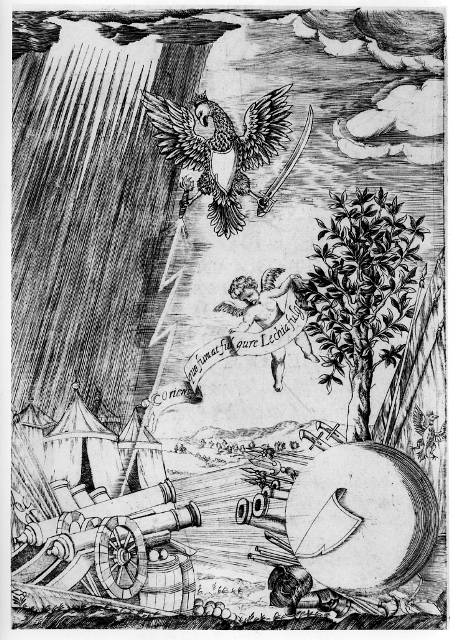
Among numerous panegyrics glorifying military achievements of Jan III Sobieski, in particular the Victory of Vienna, an outstanding work is Wojciech Bartochowski’s Fulmen Orientis Joannes III Rex Poloniarum Ter Maximus bellicae fortitudinid gloria Innocenti XI, published in 1684 in the printing house of the Jesuit College in Kalisz. Its author was the aforementioned Wojciech Bartochowski (1648–1708), bearer of the Rola coat of arms, a Jesuit and a great orator, inhabitant of the Łęczyca region. For 12 years he was a preacher at the court of Bishop Andrzej Załuski, then at St Peter’s church in Cracow. Fulmen Orientis, offered by Polish Jesuits to Jan III and considered a masterpiece in its time, contains a description of the Relief of Vienna in classic Latin prose, in an expressive, robust and vivid style, in keeping with the spirit of baroque. The reverse of the title page features a copperplate engraving which in an allegorical form glorifies the Victory of Vienna and its main protagonist, the great king.
The print depicts a vast battlefield with a range of mountains on the horizon. The forefront is filled with canons, powder kegs, cannonballs and other military items and visible further in there are tents of the Turkish camp. On the right of the composition there is the globe as smooth as crystal with the Sobieskis’ Janina coat of arms placed against a panoply and a laurel tree. Suspended in the air nearby there is a putto holding with both hands a ribbon with the following motto: Oriens quo fumat fulgure Lechia fulget. Higher up, the clouded sky is lightened by beams of radial glow and features a hovering crowned White Eagle with the Janina escutcheon on its chest. Its left talon is holding a sabre while the right one is hurling flashes of lightning. One of them is zigzagging down and striking the Turkish camp. The composition contains a very clear symbolic message. The eagle is a symbol of nobility and power; armed with the sabre, the escutcheon and lightning, it signifies the lightning-sparkling Poland, while the escutcheon itself – i.e. the Sobieski’s coat of arms – is shielding the entire contemporary Christian world. The laurel tree symbolizes courage, triumph, glory, fame and immortality of the Polish monarch. Together with the coat of arms, the tree is protecting the contemporary world against the lightning. The author of this unsigned copperplate engraving remains unknown. He was probably a local amateur printmaker, possibly from the circle of the Kalisz Jesuits. The engraving represents a low artistic level, and yet it is noted for its naïve charm and a decorative composition.
An anonymous Kalisz engraver (?): Apotheosis of the Victory of Vienna, copperplate engraving, publ. 1684.
We would like to inform that for the purpose of optimisation of content available on our website and its customisation according to your needs, we use information stored by means of cookies on the Users' end devices. You can control cookies by means of your Internet browser settings. Further use of our website without change of the browser settings means that you accept the use of cookies. For more information on cookies used by us and to feel comfortable about this subject, please familiarise yourselves with our Privacy Policy.
✓ I understand